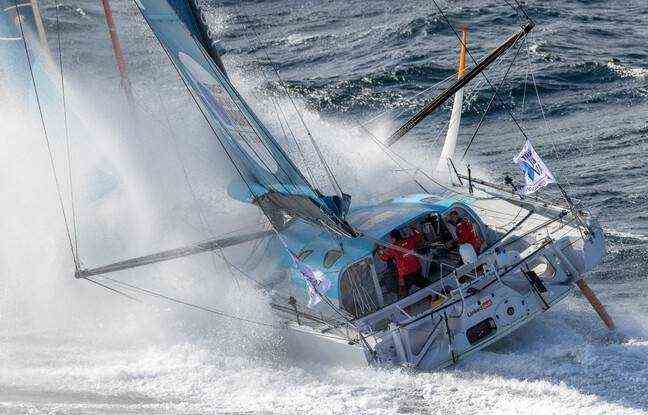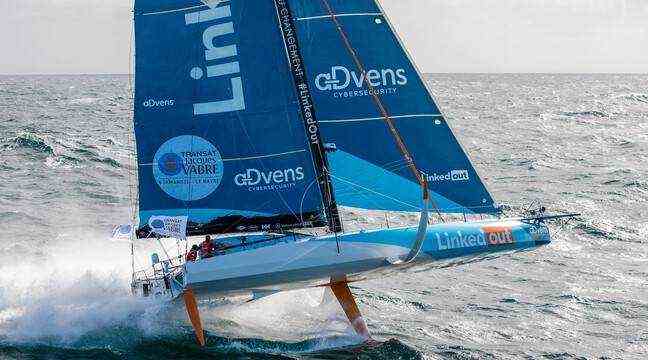They were the stars of the last Vendée Globe. Imoca foilers, the latest generation of famous 60 foot monohulls, will once again attract all eyes for the Jacques-Vabre double-handed Transat which will start
Sunday noon in Le Havre. These Formula 1 seas are able to take off and reach unprecedented speeds (up to 40 knots, or 70 km / h) thanks to their lateral appendages, the famous foils. From the outside, the sight of these sailboats out of the water is striking. But on board, what does it look like when you push them all the way? Do we really feel like we are flying?
This unusual experience is the one I had on October 20 during one of the last training trips of LinkedOut, one of the favorite boats of this Transat, helmed by Thomas Rettant and Morgan Lagravière. “You are very lucky, it will really send today …”, warned me Marcus Hutchinson, the
team manager by Thomas Rettant, before boarding. It must be said that the Aurora storm was beginning to sweep the north-west of France. And that morning, the coasts of Morbihan were already placed on alert “strong winds” by Météo France. In short, ideal conditions for “pushing the machine” and perhaps touching its record (38 knots).
The howling whistle of the foils
Less than an hour later, off the Lorient base, Eole actually slammed hard on the mainsail. Positioned at the rear of the cockpit, his eyes riveted on the numbers on his counters while avoiding as much as possible the “sea waves” falling on him, Thomas Rettant gave the signal. “Hang on tight, it’s going to bomb.” Tilted to port, the boat accelerates, seems to strike the waves less and less violently, and rises. The walls vibrate, a high-pitched whistle floods the ears. “It’s the foils that do that,” explains Morgan Lagravière. Everyone stands. Stalled as best I can between two winches, it is difficult for me to perceive what is happening but I can clearly see the bow rising and hiding the horizon. We fly.
There is no engine but the noise is hellish. The team members are screaming to communicate “performance data” to each other. Then an alarm sounds. “We let go,” orders Thomas Rettant. LinkedOut falls with a crash. “It was one of the foil sensors that rang. They alert us when the load undergone becomes too great. We have dozens of similar sensors on the boat: at the masthead, in the cables… The objective is to find the best balance between performance and preservation of the equipment. “
For nearly four hours, the crew thus renewed the speed sessions. The counter climbs to 32 knots. Sometimes, the elegant blue sailboat, carried by its foils, seems suspended in the air, three meters high. Magic moment. “When we manage to stabilize the flight, that’s the reward”, rejoices the skipper, who even allows himself to immortalize the scene on the smartphone, a few handfuls of seconds, no more. “We have to stay super vigilant so as not to have a problem. We must be attentive to all noises, to the slightest movements. Despite all the technology we have, the sensations are important. It remains extreme speeds for boats which make a ton, it is not at all harmless, especially in these conditions. “
“It’s violent but he will hold the shock”
After the flight, the descent is extremely brutal each time. Unhook an arm and it is the guaranteed fall in the middle of the ropes. Am I the only one wondering how this carbon box hasn’t split in two yet? “The faster it goes, the higher the boat can climb. And when the foil comes out of the water, it stalls and the boat falls. These are phases that we try to avoid as much as possible. It’s violent to live with but the boat has proven itself. He will hold on to the shock, ”reassures the skipper.
The repetition of the roller coaster is not just taxing on the ship. One of the staff members, however experienced in navigation, has already returned his breakfast. Soon it will be my turn. Vomiting from the back, while clinging, sprayed with salt water, is in itself an adventure. I will learn later that most sailors take a seasickness preventative tablet in these weather conditions.

Thomas Rouillard, he is in his element. “We are happy because these are really conditions that we were looking for to explore certain settings. We come back with lots of information and an understanding of the boat which is still improving. »On the Transat Jacques-Vabre, LinkedOut will have other opportunities to “bomb” and approach 40 knots. But “top speed” is not an end. “What we want is above all average speed over time. Because, sometimes, the boat can climb to 36 knots but if we fall behind to 12 knots, the compromise is not good. Whereas if we find a stable speed of 25-26 knots, that’s perfect. “
The northerner skipper may have already sailed all the oceans with his “flying machine”, having already suffered a foil damage which may have deprived him of a victory in the last Vendée Globe, he remains amazed by the performance of the Imoca foilers. “It’s a spectacular advance, there will be a before and an after, he analyzes. The foils, have seen them arrive on light supports but there, today, we fly monohulls, so boats that carry lead [la quille], it’s still pretty crazy. We manage to achieve very fast multihull speeds. They have taken ocean racing a big step. “

